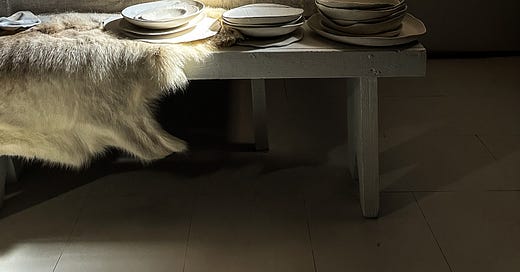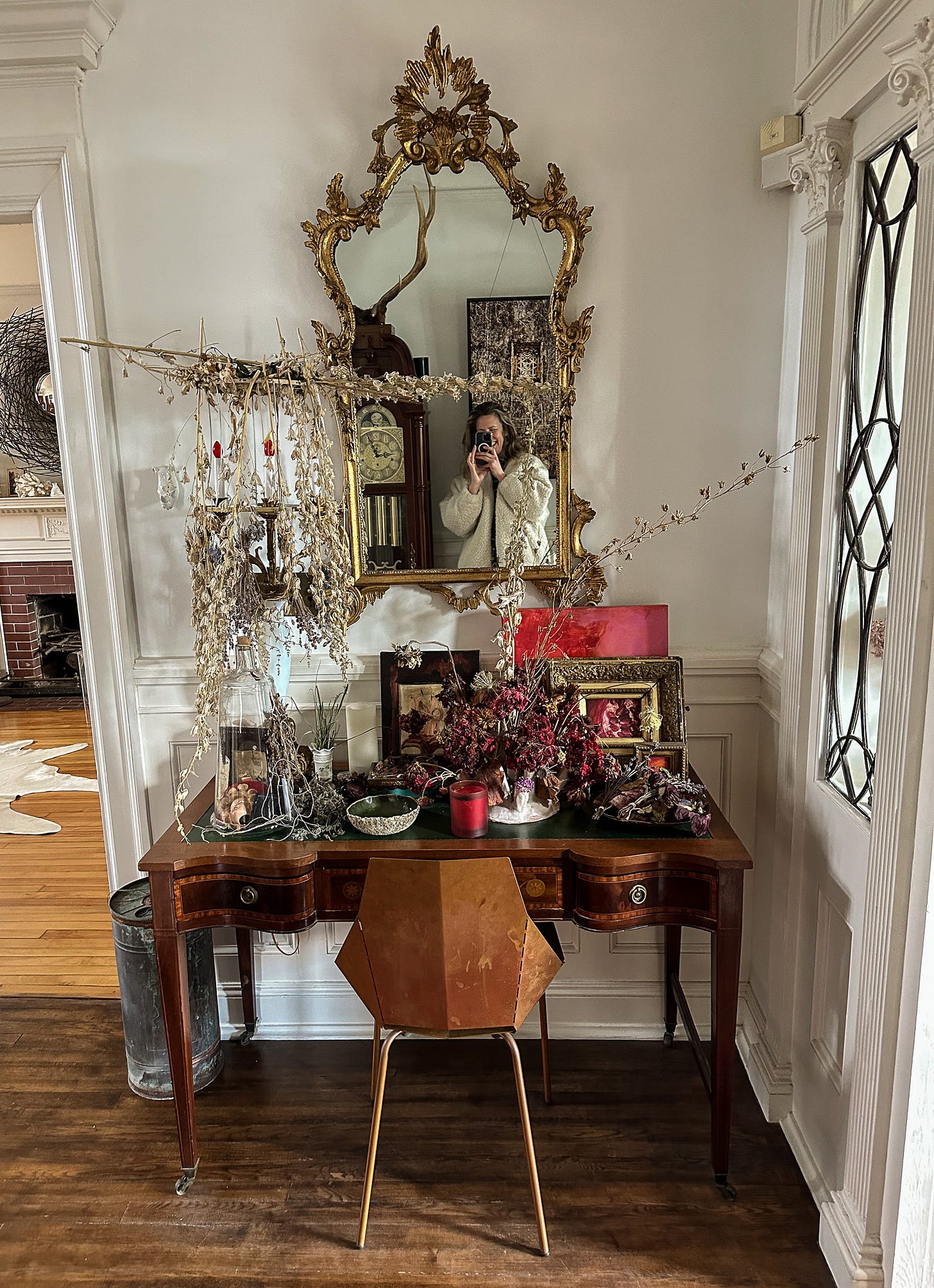
I am hosting a dinner for twelve tonight. It’s a celebration of past birthdays swallowed by the pandemic, one with dear friends and one where I don’t have to cook. My only jobs are to keep dog fur off the sofa, clear football cleats from the front hall, set the table and fill the house with branches and flowers. The latter two are my favourites. Did I mention someone else is cooking?1
I have Annabell Hickson’s book, A Tree in the House, open on my lap for inspiration. Annabelle keeps secateurs in her glove compartment at all times - my kind of woman. This morning I’ll clip magnolia branches from my mother-in-law’s garden (thanks Rose!) and perhaps some euonymus, forsythia and daffodils too if they’re still lingering. I’ll fill the gaps with flowers from the grocery store, unwrap them from their plastic and dance them around the house in unexpected places, saving the littlest flowers for the table itself.
Hickson advises against big arrangements on the table. “The most important thing to keep in mind when planning flowers for a table is that the flowers are not the most important thing on that table,” writes Hickson. She prefers to plonk a few single flowers in tiny vases. This way people can see each other across the candlelight, and allergies are kept at bay. Imagine a towering display of goldenrod and a table full of sneezes?
Tiny vases on the table doesn’t mean Hickson is tame. If she were here I bet she’d crawl up a ladder with a roll of chicken wire and construct a base to hold branches suspended from the ceiling. She bundles branches of cotton in her rural Australian kitchen, hangs them from the rafters and enjoys the cottony ceiling for weeks until bits of dried detritus fall to the ground. That’s when she takes out the broom and sweeps it away. Nature comes in, nature goes out. She says she likes that rhythm.
Last week I visited my friend Heather in her old brick home in Dartmouth. Heather is an artist of every kind. Her ceramic studio is in the basement, where the spring morning light was streaming in when I visited. Some of her work was on display - delicate plates, platters and vases sat on textured linen and sheepskins. Hand formed ceramic shells rippled down the wall as if the tide has just pulled them along.
Upstairs are high Victorian ceilings trimmed with crown molding, and everywhere sunbeams highlighted beauty. I was there to record her voice for my podcast episode on mussels, where Heather shares how she makes the delicate ceramic mussel shells that I love so much. But my eyes couldn’t settle; vignettes were everywhere. Dried wildflowers from her garden stretched above an antique desk. Paintings leaned against the wall behind candles, ceramics, and a tall glass bottle with a tribute to a small child inside. A mirror sits above it all, catching the reflection of antlers perched on top of a grandfather clock.
I love the balance of wild and precious, of order and disorder. It’s familiar to me. Like Annabel Hickson and Heather, my mother and her sisters have always brought the outdoors inside. Virginia creeper wraps up their banisters at Christmas, boughs flop across mantles, and foraged flowers fill their vases in the summer. It’s a quality my father appreciates too, but instead he finds it in baseball. This time of year he can often be found sitting on the sofa watching ‘the game’. I once asked him what it is about baseball that he loves so much.
“It’s the paradox between the wild, agrarian quality of the outfield versus the precision of the infield,” he said. Baseball infields have a fixed structure - 90 foot intervals between bases, a 60 foot six inch air space between pitcher and batter and the mounds are always 15 inches above the turf. But when it comes to the outfield, every field is different. “This is what makes the game so exciting,” he says. “It’s controlled but wild. Who knows what will happen?”
I shared this with Heather as I leaned in to inspect the dried seed pods tangled across a wall inside her garden door. “It’s the tension of the wild and the orderly that I love,” she said, understanding. “We need that tension.”
The guests are arriving in thirty minutes. It’s a rush to finish a newsletter at the eleventh hour, hoping my dress still fits and that no one will arrive early. I calm myself with the knowledge that the magnolia branch looks beautiful in the front hall with its small pink pods reaching out to welcome guests. And someone else is cooking! It’s wild and ordered, if only for tonight.
Cooking mussels is a great way to bring the wild outside into your home. Below is recipe you can hear me making on the latest episode of The Food Podcast. It’s a good one.
Thai Sweet Chili Mussels
5 lb bag of fresh Mussels
1/4 cup (60 mL) white wine
½ of a small red onion, finely chopped
4 Tbsp (60 mL) sweet Thai chili sauce
A small handful of fresh cilantro, roughly chopped
1 lime, quartered
Rinse fresh mussels under tap water. Tap any mussels that are still open and discard any that do not close after being tapped and rinsed. Set aside.
Heat a large pan fitted with a lid to medium high heat. Add the mussels then quickly add the white wine, red onions, sweet chili sauce and cilantro. Finish with a squeeze of lime and drop it on top.
Cover pan and allow to steam until mussels start to open.
Shake the pan occasionally to ensure the chili sauce coats all the mussels. When steam is escaping from the edge of the lid, they are ready. Tip mussels into a large serving bowl. Give them a stir and serve with fresh bread, for dipping into the (really good) sauce.
Chef Dennis Johnston @fidkitchen






Love that photo!
Thank you Lindsay, I loved our visit xx